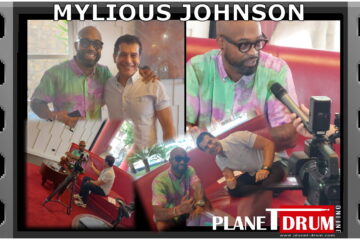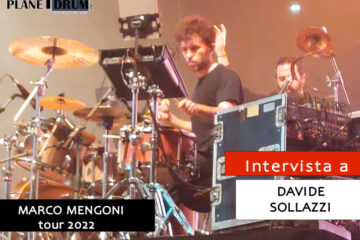Omar Hakim
Clinic Tour 2008
Omar Hakim è un batterista ed un session man di straordinario talento autore di un enorme varietà di dischi con i più grandi nomi del jazz, pop e R & B. Nato a New York City nel 1959, Hakim ha iniziato a suonare la batteria all’età di cinque anni e a dieci anni ha iniziato a suonare con suo padre, trombonista Hasan Hakim (Duke Ellington, Count Basie), ha anche suonato con il suo amico d’infanzia e futura stellla della musica fusion Marcus Miller .
Hakim è l’unica persona che può dire di aver suonato per David Bowie, Madonna, Sting e Miles Davis. “Ho avuto una naturale affinità per il ritmo sin da piccolo”, dice Hakim. “Ho iniziato a suonare la batteria a circa cinque anni, quando ho avuto una batteria giocattolo come regalo di Natale da uno zio. Ho subito cominciato a suonare uno di quei ritmi da marcia”. Il suo primo grande contratto è stato nel 1980 quando è entrato a far parte della Carly Simon’s band; subito dopo, è diventato il batterista dei Weather Report ed ha anche suonato per David Bowie sul disco Let’s Dance.
“La mia carriera ha preso veramente il volo nel 1980”, ricorda Hakim. “Ho incontrato un ragazzo di nome Mike Mainieri, un premiato vibrafonista jazz, che ha anche prodotto Carly Simon. Carly aveva bisogno di un batterista, così ha chiamato me. Quando suoni per molti artisti e sei sui palchi la parola inizia a diffondersi piuttosto rapidamente. Sono stato l’ultimo batterista dei Weather Report, ma quella band ha cambiato la mia carriera”, dice Hakim.”Sting, Mark Knopfler dei Dire Straits erano appassionati dei Weather Report e mi hanno visto suonare con i Weather Report”.
È rimasto con i Weather Report fino allo scioglimento del gruppo nel 1985, per poi suonare con Sting in The Dream of the Blue Turtles e con i Dire Straits in Brothers in Arms. Intanto Omar Hakim impara a programmare le drum machine permettendogli di mettersi in vetrina ottenendo contratti nel pop, rock, R & B sino a suonare con Madonna.
“L’elettronica ha cambiato la vita dei batteristi”, spiega Hakim “ma invece di sentirmi sconfitto ho deciso di andare in un negozio di musica, acquistare una drum machine e imparare a utilizzare questo strumento”.
“Ho seguito il corso della tecnologia e della batteria elettronica dagli anni’80 fino ad oggi, devi rimanere in cima a questi cambiamenti tecnologici. E ‘molto importante se sei un musicista professionista.”
Nel frattempo ha continuato il suo lavoro come batterista jazz fusion; un elenco parziale dei suoi crediti nel corso degli anni’80 e ’90 include lavori con Miles Davis, David Sanborn, Roy Ayers, George Benson, Joe Sample, John Scofield, Lee Ritenour, e Najee. Nel 1989, Hakim rilascia il suo primo album da solista, Rhythm Deep, una via di mezzo tra il jazz, R & B e pop che gli diede la possibilità di mostrare anche la sua abilità vocale. I risultati ottenuti gli assicurarono una nomination al Grammy. Durante gli anni’90, Hakim ha continuato a migliorare le sue competenze nel campo delle percussioni elettroniche mantenendo il passo delle nuove tecnologie e, quindi, mantenendo la sua carriera in buona salute. Ha suonato sugli album di Mariah Carey, Celine Dion, e Jewel, mantenendo la sua attività jazz. Nel 2000, Hakim rilascia il suo secondo album solista, The Groovesmith, interamente prodotto sul proprio sistema Macintosh ProTools e che ha avuto un approccio musicale simile al suo primo sforzo.
“A volte, se le persone che ti conoscono dal genere Rock pensano che tu sia un batterista rock e non si aspettano di vederti in qualsiasi altro genere. Oppure, se ti vedono per la prima volta in un contesto jazz, ti etichettano come un batterista jazz”, spiega Hakim. “Ero consapevole del fatto che non avevo voglia di essere etichettato come batterista rock o un batterista jazz, ma volevo essere considerato un musicista totale. Così ho sempre fatto in modo di far conoscere alle persone che cosa fosse per me la musica. Sapevo che impostare la mia carriera in questo modo significava rendere la mia vita molto interessante aprendomi la mente da un punto di vista musicale”, spiega Hakim “è stato sempre molto importante per me espormi in modo che tutto ciò mi facesse crescere come musicista.”.
Omar Hakim is a fusion drummer and session man extraordinaire whose talents have graced a tremendous variety of big name recordings in the jazz, pop, and R&B fields dating back to the early ’80s. Born in New York City in 1959, Hakim began playing drums at age five, and by age ten was performing with his father, swing trombonist Hasan Hakim (Duke Ellington, Count Basie); he also performed with boyhood friend and future fusion star Marcus Miller.
Hakim may be the only person who can say he’s played drums for David Bowie, Madonna, Sting and Miles Davis. “I had a natural affinity for drums and rhythm very young,” says Hakim. “I started playing drums at about age five, when I got a toy drum as a Christmas gift from an uncle. They strapped that thing around my neck and I immediately started playing one of those marching cadence kind of beats.”
He landed his first big break in 1980 when he joined Carly Simon’s backing band; soon after, he became the drummer for Weather Report in time for 1982’s Record, and he also landed a gig playing on David Bowie’s return to the American pop charts, Let’s Dance.
“My career really took off in 1980,” recalls Hakim. “I met a guy named Mike Mainieri, an award-winning jazz vibraphonist, who also produced Carly Simon. Carly needed a drummer, so he hired me to play in her band.” When you get out there and people see you play, the word of mouth starts spreading pretty quickly,”. “I was the last drummer in Weather Report , but that band turned my career around,” says Hakim. “Sting and Dire Straits’ Mark Knopfler were fans of Weather Report and they saw me playing with the group.”
He remained with Weather Report until the group’s breakup in 1985, and his high-profile engagements helped land him work on Sting’s The Dream of the Blue Turtles and Dire Straits’ Brothers in Arms, among others. By this time, Hakim was teaching himself to program drum machines, which put him in even greater demand as a pop, rock, and R&B session musician, and landed him work with Madonna. “This changed drummers’ lives all over,” explains Hakim. “But instead of feeling defeated by the whole trend, I decided to go my local music store, purchase a drum machine and learn how to use it.”
“I’ve pretty much followed the changes with electronic drumming from the 80s up until now,” he says. “You’ve gotta stay on top of these technological changes. It’s very important if you’re a professional musician.”
Meanwhile, he continued his work as a jazz fusion drummer; just a partial list of his credits over the ’80s and ’90s includes work with Miles Davis, David Sanborn, Roy Ayers, George Benson, Joe Sample, John Scofield, Lee Ritenour, and Najee. In 1989, Hakim released his first solo album, Rhythm Deep, which occupied a middle ground between jazz, R&B, and pop, and gave him a chance to showcase his vocal abilities as well. The results earned Hakim a Grammy nomination. During the ’90s, Hakim continued to improve his skills in the realm of electronic percussion, keeping abreast of new technologies and thereby keeping his session career in good stead. He performed on albums by Mariah Carey, Celine Dion, and Jewel, among other big time pop stars, and initially kept his jazz work going as well, though it had tapered off by the middle of the decade. In 2000, Hakim released his second solo album, The Groovesmith, which took a musical approach similar to his first effort and was produced on his own Macintosh ProTools system.
“Sometimes, if people know you from rock, they think of you as a rock drummer and don’t expect you to play anything else. Or, if they know you in jazz, then they typecast you as a jazz drummer,” explains Hakim. “I was conscious of the fact that I didn’t want people to know me as a rock drummer or a jazz drummer, but as a total musician. So I always made sure I let people know that I was about music.” “I knew that setting up my career in this way was going to make my life very interesting and would keep me open-minded musically,” explains Hakim. “It was always very important to me that I expose myself to everything so that I could grow as a musician.”


